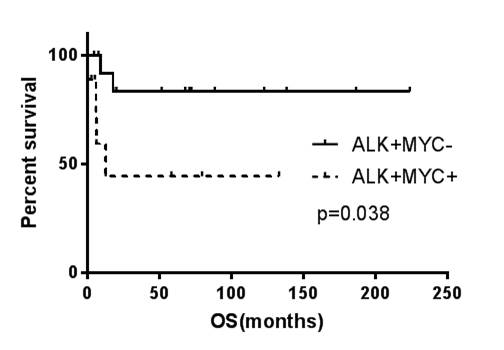Background: Dysregulation of MYC has oncogenic potential. It has been reported that MYC dysregulation (gene rearrangement, increased copy number, and protein overexpression) predicts poorer prognosis in patients with diffuse large B cell lymphoma. Systemic anaplastic large cell lymphoma (ALCL) is a T cell lymphoma with strong, uniform CD30 expression. Although some in vitro studies showed MYC signaling is essential for the survival of ALCL cells, the possible role of MYC expression in the clinicopathologic features and outcome of ALCL patients has not been reported.
Method: We studied 70 patients with systemic ALCL (31 ALK+ and 39 ALK-negative) in whom MYC expression was assessed by immunohistochemistry at the time of diagnosis. The positive cut-off value for MYC was > 40%. The clinicopathologic features and outcome of patients with MYC+ tumors were compared to patients with MYC-negative tumors in both the ALK+ and ALK-negative ALCL groups, respectively. Fisher's exact test was used to compare the clinicopathologic features of the MYC+ and MYC-negative groups. Overall survival (OS) was analyzed using the Kaplan-Meier method and compared using the log-rank test.
Results: There was no difference in the frequency of MYC positivity rate between ALK+ vs. ALK-negative ALCL (39% vs 26%, p = 0.30). In ALK+ ALCL, patients with a MYC+ tumor more often had an increased serum LDH level than those with a MYC-negative tumor (86% vs 25%, p = 0.04), and they tended to have a higher frequency of common morphology (100% vs 68%, p = 0.059). No significant difference was observed in the treatment between MYC+ vs MYC-negative groups in patients with ALK+ ALCL (p > 0.05). MYC expression was associated with shorter OS in patients with ALK+ ALCL (median survival 12.8 months vs undefined, p = 0.038; Figure). In ALK-negative ALCL, patients with a MYC+ tumor were more often older (median age 66.5 years, range 46-95 years) than those with a MYC-negative tumor (median age 56 years, range 21-77 years) (p = 0.02); they also tended to have less advanced (stage III to IV) disease (43% vs 85%, p = 0.05). ALK-negative MYC+ ALCL showed less frequent CD3 expression (20% vs 67%, p = 0.02) and a trend of decreased CD4 expression (67% vs 96%, p = 0.05), compared to their ALK-negative MYC-negative counterparts. There was no significant difference in treatment between MYC+ vs MYC-negative groups in patients with ALK-negative ALCL (p > 0.05). MYC expression was not associated with OS in patients with ALK-negative ALCL (p = 0.35).
Conclusions: MYC expression is independent of ALK status in ALCL and appears to have distinct clinicopathologic and prognotstic roles in ALK+ vs ALK-negative ALCL. In ALK+ ALCL, MYC expression is associated with an elevated serum LDH level and shorter OS. In ALK-negative ALCL, MYC expression is associated with older age and less frequent CD3 expression, but does not predict OS. These data suggest that MYC expression in ALK+ ALCL may be a poor prognostic factor.
Bueso-Ramos:Incyte: Consultancy.
Author notes
Asterisk with author names denotes non-ASH members.


This feature is available to Subscribers Only
Sign In or Create an Account Close Modal